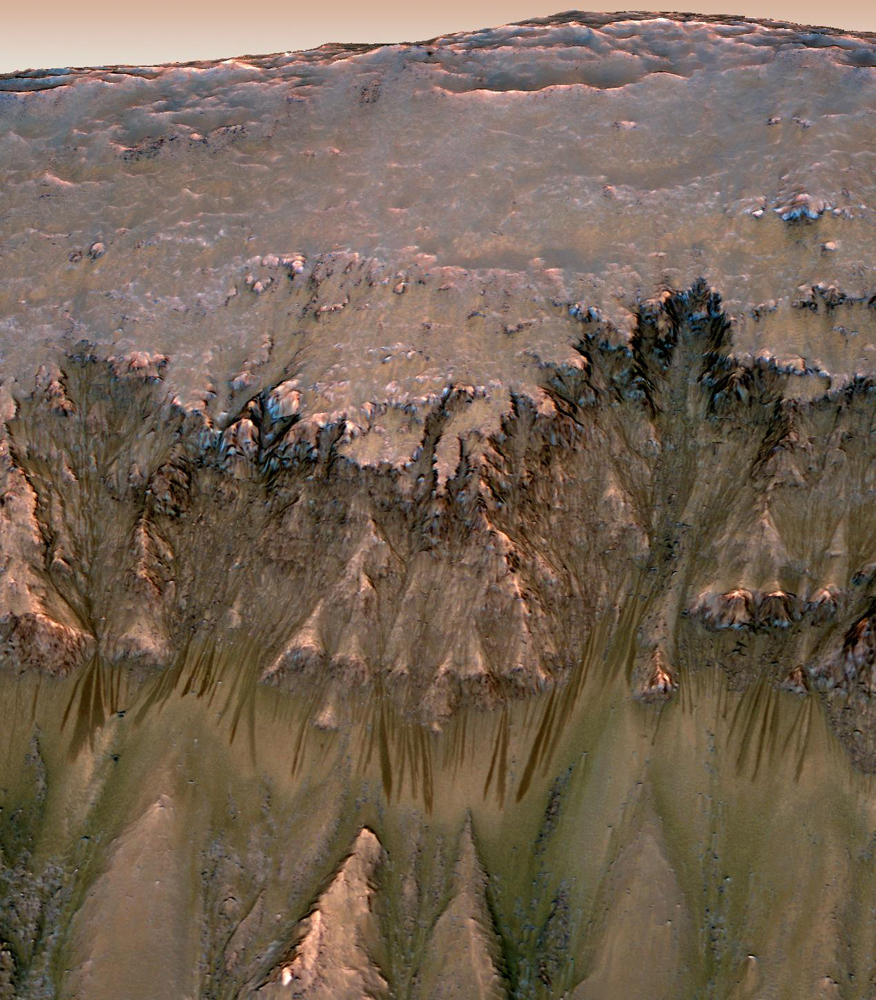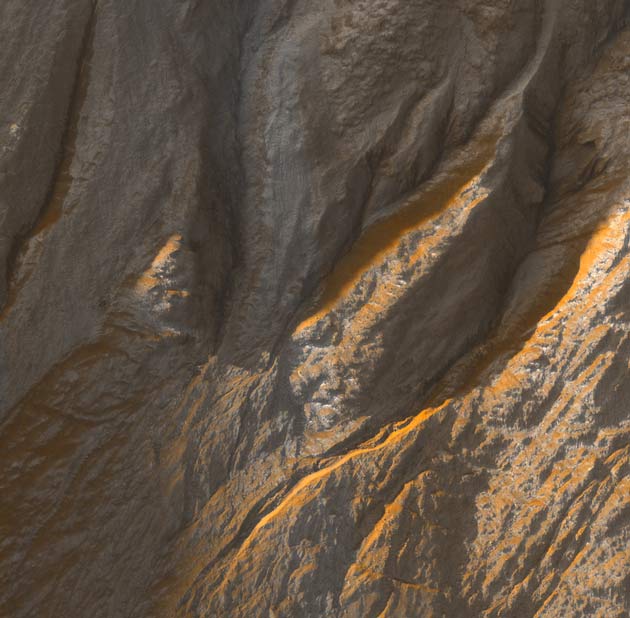Flowing Water on Mars? Strange Red Planet Features Stir Debate (original) (raw)

This image combining orbital imagery with 3-D modeling shows flows that appear in spring and summer on a slope inside Mars' Newton crater. (Image credit: NASA/JPL-Caltech/Univ. of Arizona)
Flow-like features on Mars are a source of debate among scientists. While some experts say they are likely produced by liquid water or brine on the Red Planet's surface today, other investigations interpret some of these features as dry mass movements, stirred up by various other processes.
Whatever the cause, these slope streaks — called Recurring Slope Lineae — represent the movement of mass down slopes on the surface of our neighboring planet. They are among the few known examples of current geologic activity on Mars.
Many scientists agree that water likely flowed across ancient Mars. However, whether it exists as a liquid on the planet's surface today is arguable.
Recurring Slope Lineae are dark, narrow features that extend on steep, equator-facing, mid-latitude rocky slopes of Mars. Furthermore, they form and grow during multiple warm seasons, and fade in cold seasons.
The head-scratching phenomenon sparked a lively debate on what's behind the strange slope processes on Mars during last week's 43rd Lunar and Planetary Science Conference in The Woodlands, Texas. [Photos: The Search for Water on Mars]
SPACE.com spoke to several scientists involved in the research, who gave us a glimpse into what may be happening on Mars.
Ongoing drainage system
Breaking space news, the latest updates on rocket launches, skywatching events and more!
Conditions are such on present-day Mars that, at certain locations at certain times of year, liquid water should be capable of existing for short amounts of time, according to Jim Head and Jay Dickson of the department of geological sciences at Brown University in Rhode Island.
The best evidence that water currently exists there comes from the recent discovery in the southern mid-latitudes of Recurring Slope Lineae, or RSL for short.
Dickson and Head described their research findings, showing that identical features are found on the equator-facing wall of the South Fork of Upper Wright Valley in the McMurdo Dry Valleys of Antarctica.
"If this is correct, then RSL on Mars may represent the surface expression of a far more significant ongoing drainage system on steep slopes in the mid-latitudes," the team said.

Crater edge in Terra Sirenum has been imaged by the High Resolution Imaging Science Experiment (HiRISE) camera on NASA's Mars Reconnaissance Orbiter. Gully watching thanks to repeat sweeps over the same landscape by orbiting spacecraft could catch gullies in action, if they are active today. (Image credit: NASA/JPL/University of Arizona)
Islands of persistence
In research led by Norbert Schörghofer, of the University of Hawaii's Institute for Astronomy in Honolulu, a selected study site on Mars revealed the coming-and-going nature of slope streaks.
"For the first time we see an approximate balance between faded and new streaks," Schörghofer said. "The rate of formation and rate of fading are nearly equal, revealing that the number of slope streaks on the surface of Mars is approximately constant rather than increasing with time. This indicates the streak population is balanced."
The average lifetime of slope streaks, from time of formation until they disappear, and the turnover time of the slope streak population, are estimated to be four decades, Schörghofer said. Slope streaks fade gradually over time, with "islands of persistence," and are not obliterated by planet-encircling dust storms.
Rolling and tumbling
So, what on Mars is actually going on?
A formidable tool in helping to spot and catalog these confounding features is NASA's Mars Reconnaissance Orbiter, or MRO, now circling the Red Planet.
"This is complicated," said Alfred McEwen, a planetary geologist and director of the Planetary Image Research Laboratory at the University of Arizona in Tucson."Lots of stuff moves down steep slopes on both Earth and Mars." McEwen is principal investigator of the High Resolution Imaging Science Experiment (HiRISE) on the MRO.
On Mars, there are several rolling and tumbling categories, McEwen told SPACE.com:
- Slope streaks on dusty equatorial slopes. These are fully explained as dust avalanches.
- Slope streaks associated with the presence — especially defrosting — of carbon dioxide (CO2) frost, so CO2-aided mass wasting explains this. This category includes active gullies. The only distinction is whether or not HiRISE images can resolve the topographic changes.
- Lineaments associated with dry boulder/debris falls.
- Recurring Slope Lineae may look superficially similar to the other categories, but form only under very particular environmental conditions, in places where there is no CO2 frost. They grow incrementally, and they recur each summer. So far, only the flow of briny water seems to be able to explain these.
"Folks can invoke water for all of the above if they like water. But given the thermodynamics," McEwenadded, "it is extremely unlikely except, maybe, for the RSL. They all have excellent non-water explanations except the RSL. Maybe the RSL will eventually prove to have a dry explanation as well."
Leonard David has been reporting on the space industry for more than five decades. He is a winner of last year's National Space Club Press Award and a past editor-in-chief of the National Space Society's Ad Astra and Space World magazines. He has written for SPACE.com since 1999.
Join our Space Forums to keep talking space on the latest missions, night sky and more! And if you have a news tip, correction or comment, let us know at: community@space.com.
Leonard David is an award-winning space journalist who has been reporting on space activities for more than 50 years. Currently writing as Space.com's Space Insider Columnist among his other projects, Leonard has authored numerous books on space exploration, Mars missions and more, with his latest being "Moon Rush: The New Space Race" published in 2019 by National Geographic. He also wrote "Mars: Our Future on the Red Planet" released in 2016 by National Geographic. Leonard has served as a correspondent for SpaceNews, Scientific American and Aerospace America for the AIAA. He has received many awards, including the first Ordway Award for Sustained Excellence in Spaceflight History in 2015 at the AAS Wernher von Braun Memorial Symposium. You can find out Leonard's latest project at his website and on Twitter.